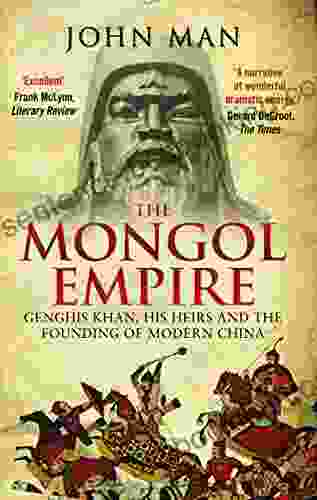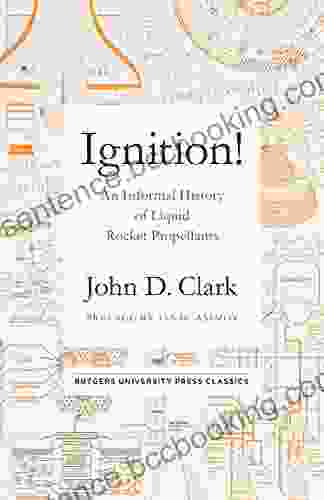**Ignition: An Informal History of Liquid Rocket Propellants**

The history of liquid rocket propellants is a fascinating one, filled with tales of scientific breakthroughs, daring experiments, and technological marvels. From the early days of gunpowder to the modern era of cryogenic propellants, the quest for better and more powerful fuels has driven the development of rocketry and space exploration.
The earliest rockets were solid-fueled, using gunpowder or other explosive materials to propel themselves. These rockets were simple and relatively inexpensive, but they were also inefficient and dangerous.
In the early 19th century, scientists began to experiment with liquid propellants. Liquid propellants are more efficient than solid propellants, and they can be controlled more precisely. However, liquid propellants are also more volatile and difficult to handle.
4.7 out of 5
| Language | : | English |
| File size | : | 3521 KB |
| Text-to-Speech | : | Enabled |
| Screen Reader | : | Supported |
| Enhanced typesetting | : | Enabled |
| X-Ray | : | Enabled |
| Word Wise | : | Enabled |
| Print length | : | 302 pages |
The first successful liquid-fueled rocket was developed by Robert Goddard in 1926. Goddard's rocket used liquid oxygen and gasoline as propellants, and it achieved a speed of over 60 mph.
In the 1950s, scientists began to develop cryogenic propellants, which are propellants that are stored at very low temperatures. Cryogenic propellants are more efficient than conventional liquid propellants, and they can be used to achieve higher speeds.
The first successful cryogenic propellant was liquid hydrogen. Liquid hydrogen is the lightest and most efficient propellant known, but it is also extremely cold (-423 degrees Fahrenheit).
In 1957, the United States launched the first successful cryogenic rocket, the Atlas-Agena. The Atlas-Agena used liquid oxygen and liquid hydrogen as propellants, and it was able to achieve a speed of over 12,000 mph.
The space race between the United States and the Soviet Union drove the development of liquid rocket propellants. Both countries were eager to develop more powerful rockets that could reach the moon and beyond.
The United States used cryogenic propellants to develop the Saturn V rocket, which was used to launch the Apollo missions to the moon. The Saturn V was the most powerful rocket ever built, and it used liquid oxygen and liquid hydrogen as propellants.
The Soviet Union also used cryogenic propellants to develop the N-1 rocket, which was intended to compete with the Saturn V. However, the N-1 rocket was never successful, and it was eventually abandoned.
The space race ended in the 1970s, but the development of liquid rocket propellants has continued. Today, liquid propellants are used in a wide variety of rockets, including satellites, space probes, and interplanetary missions.
In recent years, there has been a growing interest in developing new and more efficient liquid rocket propellants. These new propellants could lead to the development of more powerful rockets that can reach even further into space.
The history of liquid rocket propellants is a story of innovation, perseverance, and scientific achievement. From the early days of gunpowder to the modern era of cryogenic propellants, the quest for better and more powerful fuels has driven the development of rocketry and space exploration.
Today, liquid propellants are used in a wide variety of rockets, including satellites, space probes, and interplanetary missions. As the space race continues, the development of new and more efficient liquid rocket propellants will continue to play a vital role in the exploration of space.
Ignition: An Informal History of Liquid Rocket Propellants is a comprehensive and fascinating look at the history of liquid rocket propellants. The book covers the early days of rocketry, the development of cryogenic propellants, the space race, and the modern era of rocketry.
Ignition is written by John Clark, a former NASA engineer and author of several other books on space exploration. The book is well-researched and engagingly written, and it is sure to appeal to anyone interested in the history of rocketry and space exploration.
To Free Download your copy of Ignition, please click here.
- NASA: Liquid Rocket Propellants
- Encyclopedia Britannica: Liquid Rocket Propellants
- Rocket Propulsion Elements
4.7 out of 5
| Language | : | English |
| File size | : | 3521 KB |
| Text-to-Speech | : | Enabled |
| Screen Reader | : | Supported |
| Enhanced typesetting | : | Enabled |
| X-Ray | : | Enabled |
| Word Wise | : | Enabled |
| Print length | : | 302 pages |
Do you want to contribute by writing guest posts on this blog?
Please contact us and send us a resume of previous articles that you have written.
 Book
Book Novel
Novel Page
Page Chapter
Chapter Text
Text Story
Story Genre
Genre Reader
Reader Library
Library Paperback
Paperback E-book
E-book Magazine
Magazine Newspaper
Newspaper Paragraph
Paragraph Sentence
Sentence Bookmark
Bookmark Shelf
Shelf Glossary
Glossary Bibliography
Bibliography Foreword
Foreword Preface
Preface Synopsis
Synopsis Annotation
Annotation Footnote
Footnote Manuscript
Manuscript Scroll
Scroll Codex
Codex Tome
Tome Bestseller
Bestseller Classics
Classics Library card
Library card Narrative
Narrative Biography
Biography Autobiography
Autobiography Memoir
Memoir Reference
Reference Encyclopedia
Encyclopedia Katie Munday Williams
Katie Munday Williams Xiufeng Liu
Xiufeng Liu Katherine Routledge
Katherine Routledge Jim Randel
Jim Randel Krishna Swaroop Achanta
Krishna Swaroop Achanta Susan E Massenzio
Susan E Massenzio L T Vargus
L T Vargus Jonathan Clements
Jonathan Clements Joseph Pearce
Joseph Pearce Walter Gibson
Walter Gibson Joe Minihane
Joe Minihane John Hope Franklin
John Hope Franklin Johanna Davis
Johanna Davis Thomas J Campanella
Thomas J Campanella Patti Rokus
Patti Rokus Jim Meuninck
Jim Meuninck Joe Kane
Joe Kane John Henry Phillips
John Henry Phillips Joan Marsh
Joan Marsh Joel Best
Joel Best
Light bulbAdvertise smarter! Our strategic ad space ensures maximum exposure. Reserve your spot today!

 Henry David ThoreauUnveiling the Extraordinary Life and Legacy of Ida Wells: A Pioneer for Truth...
Henry David ThoreauUnveiling the Extraordinary Life and Legacy of Ida Wells: A Pioneer for Truth... Mikhail BulgakovFollow ·8.3k
Mikhail BulgakovFollow ·8.3k Martin CoxFollow ·13.8k
Martin CoxFollow ·13.8k Ralph TurnerFollow ·9.6k
Ralph TurnerFollow ·9.6k Anton FosterFollow ·14.8k
Anton FosterFollow ·14.8k Eric NelsonFollow ·14.7k
Eric NelsonFollow ·14.7k Johnny TurnerFollow ·16.5k
Johnny TurnerFollow ·16.5k Jesus MitchellFollow ·9.1k
Jesus MitchellFollow ·9.1k Stuart BlairFollow ·9.2k
Stuart BlairFollow ·9.2k

 Jesus Mitchell
Jesus MitchellDiscover the World of Satisfying Meals with Or...
In a world where culinary creations often...

 Darius Cox
Darius CoxJourney into the Extraordinary Life of Kublai Khan: An...
Immerse Yourself in the Fascinating...

 Gil Turner
Gil TurnerThe Fourth Industrial Revolution: The Precariat and the...
In his groundbreaking book, The Fourth...

 Jonathan Franzen
Jonathan FranzenGenghis Khan: His Heirs and the Founding of Modern China
Genghis Khan, the...

 Eugene Powell
Eugene PowellJourney Through the Golden Age of the Ottoman Empire with...
Delve into the Enchanting World of the...
4.7 out of 5
| Language | : | English |
| File size | : | 3521 KB |
| Text-to-Speech | : | Enabled |
| Screen Reader | : | Supported |
| Enhanced typesetting | : | Enabled |
| X-Ray | : | Enabled |
| Word Wise | : | Enabled |
| Print length | : | 302 pages |












